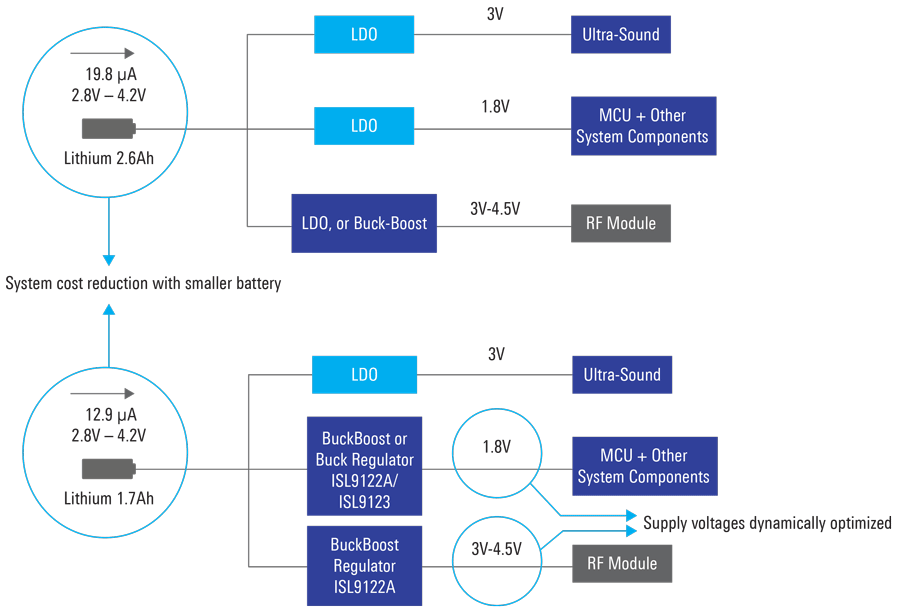Trends in Battery-Operated Devices
Recent trends in battery-operated devices increase demand for powering always-connected IoT and strongly favor efficient DC/DC power conversion products. Target markets for battery-operated products include virtually all battery-operated devices where battery life has to be long compared to average power consumption. This is especially true for devices that require a lifetime of days to years.
In addition, increased adoption of wireless connectivity drives the need for voltages higher than that of the battery and at the same time, requires more efficient use of battery charge. DC/DC converter devices that can dynamically change their output voltage based on the needs of the application can greatly enhance the efficiency and extend the battery lifetime. Our ISL9122 buck-boost converter satisfies all the power requirements mentioned above.
Key Features
The ISL9122 belongs to a family of ultra-low Iq DC/DC regulators with advantages that can be grouped into three different categories:
- Battery voltage range: With an input voltage range of 1.8V to 5.3V, this family of regulators is suitable for applications with multiple types of batteries, such as Alkaline, Li-ion, Li-polymer
- Power consumption: This family of parts has three distinct advantages with respect to battery life – low Iq, 1.3µA, and a shutdown current of <9nA – allowing batteries to last for a very significant amount of time
- Flexibility: The I2C interface provides maximum flexibility to change output voltage in 25mV increments which allows system designers to change Vout dynamically depending on the power needs of the system
Application Examples
Water and Gas Meters: One use case for a DC/DC converter such as ISL9122 is in water and gas meters which typically require >10 years of battery life. Below is an example comparing power conversion done in a typical design using an LDO with a new design using a DC/DC converter such as the ISL9122.

Figure 1. Battery Life Optimization for Energy Management Systems
As seen in the top block diagram, an implementation using an LDO for power conversion on average draws 19.8µA from the battery. Since LDOs are very inefficient when there is a large conversion ratio between the input and the output, most of the charge in the battery is converted into heat and wasted. When the ISL9122 is used instead of an LDO, the current drawn from the battery to run the same application is reduced on average to 12.9µA. This example shows that when using ISL9122, the lifetime of the battery can be increased by 50%. Or equivalently, the cost of the battery can be decreased by 50%.
RF Optimization for IoT: This example shows how using Dynamic Voltage Scaling (DVS), Vout can be increased whenever there is a need to transmit data wirelessly to the network. During times when there is no transmission or the wireless interface is in sleep mode, the regulator output can be reduced enough to sustain the MCU. Since power consumption increases with the square of the voltage, reducing Vout when not needed saves a significant amount of power.

Figure 2. RF Optimization for IoT Systems
The new class of ultra-low Iq DC/DC regulators from Renesas are the ideal power solution for any device powered by a small battery. With ultra-low Iq, high efficiency at both light and heavy loads, as well as fast transient response these devices maximize battery life without any compromise in performance. In particular, the small, highly flexible ISL9122 buck-boost regulator increases battery life for connected smart devices.
For more information on the ISL9122 including datasheets and samples, please visit our ISL9122 product page. To see the complete portfolio of high-performance integrated FET regulators, visit our Buck-boost Regulators (Integrated FETs) page.
